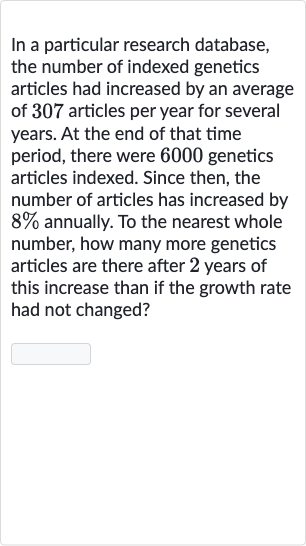AI tutor
Welcome to Bytelearn!
Let’s check out your problem:

In a particular research database, the number of indexed genetics articles had increased by an average of articles per year for several years. At the end of that time period, there were genetics articles indexed. Since then, the number of articles has increased by annually. To the nearest whole number, how many more genetics articles are there after years of this increase than if the growth rate had not changed?◻
Full solution
Q. In a particular research database, the number of indexed genetics articles had increased by an average of articles per year for several years. At the end of that time period, there were genetics articles indexed. Since then, the number of articles has increased by annually. To the nearest whole number, how many more genetics articles are there after years of this increase than if the growth rate had not changed?◻
- Calculate Initial Growth Rate: Calculate the number of articles after years with the original growth rate of articles per year.Number of articles after years = Initial number of articles + (Growth per year Number of years)= articles + ( articles/year years)= articles + articles= articles
- Calculate New Growth Rate: Calculate the number of articles after years with the new % annual growth rate.First, calculate the number of articles after the first year.Number of articles after year = Initial number of articles ( + Growth rate)= articles = articles = articles
- Calculate Growth Rate After Years: Calculate the number of articles after the second year with the \% growth rate.Number of articles after years = Number of articles after year * = articles * = articles * = articlesSince we need the nearest whole number, we round to articles.
- Find Difference in Growth Rates: Find the difference in the number of articles after years between the two growth rates.Difference = Number of articles after years with growth - Number of articles after years with growth per year= articles - articles= articles
More problems from Percent of change: word problems
QuestionGet tutor help
QuestionGet tutor help
